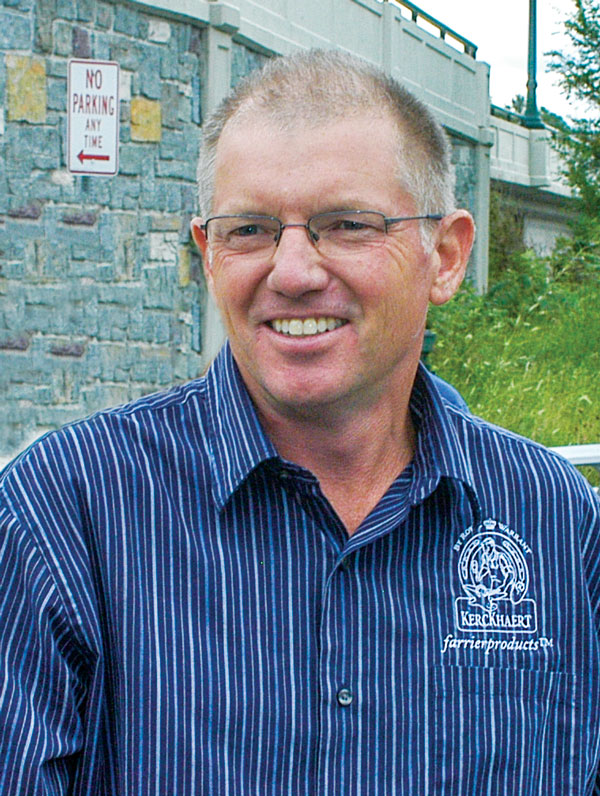The best way to assess a horse’s conformation is to view it from a variety of perspectives. Looking at a horse in cross-ties will only provide you one angle. At a minimum, watch the horse walk out of the stall toward you. If this is all you do, it’s a positive first step — but you are still missing a lot of information. You will be better served to collect a variety of views of the horse.
I had the opportunity to observe how International Horseshoeing Hall of Fame member Seamus Brady evaluated a horse — he went to its events and he watched it warm up — he saw what it was doing in different environments and at different times. This level of observation is invaluable to a farrier. There are certain visual clues a horse can provide that will help us define what’s going on internally and how to address it through proper hoof care. Observe the horse from the front as well as the hind. Your perspective will change with the direction from which it is viewed — and change is constant. Look down the horse’s limb and identify the locations of twists and bends; try to envision where the pinching points are so you can help change the stresses to that limb. Ask another person to view the horse — perhaps an apprentice to verify what you are seeing and provide additional insight.
Besides this basic visual assessment, accumulate additional information to aid in helping the horse — look at radiographs, MRIs, cat scans — then put it together. Long before you begin working on the hoof, start forming a vision of what you want to do to help that horse; to change its balance or its posture — yes, you can change its posture. Understand that what you do today may not be what you do in 4 weeks when you work on the horse again. There will be new changes reflected from what the horse has been doing, its nutrition, its environment and your previous shoeing job. Everything that you do to that foot on this visit will have an influence on the entire body of that animal that you can see in future visits.
Physically examining the horse is another way to gather important information about a horse’s conformation. You can do this by extending the limbs in the natural range of motion. Some horses may extend a foot just in front of the opposite limb; while others may have a greater or different range of motion. The deviations within the limb will create pinch points and if you put more pinch on it you are going to get a negative response. Flex the limbs and feel the joints. If you’ve been working on a horse consistently and you find one day you go to lift up the hind limb and the horse is less responsive to what you’re doing, it’s important to let someone know about the change in behavior. Otherwise pretty soon you’ll be shoeing it down on the toe of your steel-toed shoe because the horse can’t lift it up anymore.
If you want to validate what you’re doing and what your perceptions are — watch the horse and its reaction. That’s going to tell you a lot about what the horse is feeling. You may find some horses are quite uncomfortable before you start, and just the opposite after you finish. When you set that foot down, watch for licking and chewing. When they lift up the contralateral limb to put weight on the one you’ve just worked on — that’s a good sign. If not, you may have a problem. Look to the horse to determine if you are on the right path, because the horse is going to tell you. It’s not just that its performance is improving; maybe the horse’s attitude changes, or its stance changes — all of those things are important validations of your work.
The next step is to evaluate the hoof conformation for form and function. This is something we can keenly understand because hoof-care professionals, like the horses we work on, have certain stresses to our body and pathologies resulting from repetitive behavior. It stands to reason if you are working with a hoof between your legs all the time, that you are going to wear the outside and the heels of your shoes. One heel may wear more than another, depending on the conformational deviations within your limb.
When I first started out, I didn’t care about my own shoes — I just hoped my first client paid in cash so I could buy gas to get to the next. But as my shoes wore out, my gait changed. All of a sudden I’m traveling more base narrow, close together. I’m starting to feel pain. I am having compression of the joints on the inside of my limb and elongation of the soft tissues on the outside where those deviations are. If I had just gotten myself new shoes, I could have prevented a lot of issues.
The horse is the same way. Look at the hoof. How is it wearing? Where is it wearing? Which way is the hoof capsule moving? The answers to those questions all provide information that you can use.
Learn More
- Equine Body Conformation Should Inform Your Approach to Farriery: Rotational, flexural and angular deviations result in hoof-care needs that are unique from horse to horse and hoof to hoof.
- Are You Considering More Than Feet When You Trim And Shoe?: Understanding deviations will guide you in helping the horse, Hall Of Fame farrier tells Summit attendees
- Understand Drafts' Farriery Needs Before Picking Up the Foot: Tips and advice to make trimming and shoeing easier for you and the horse.








Post a comment
Report Abusive Comment